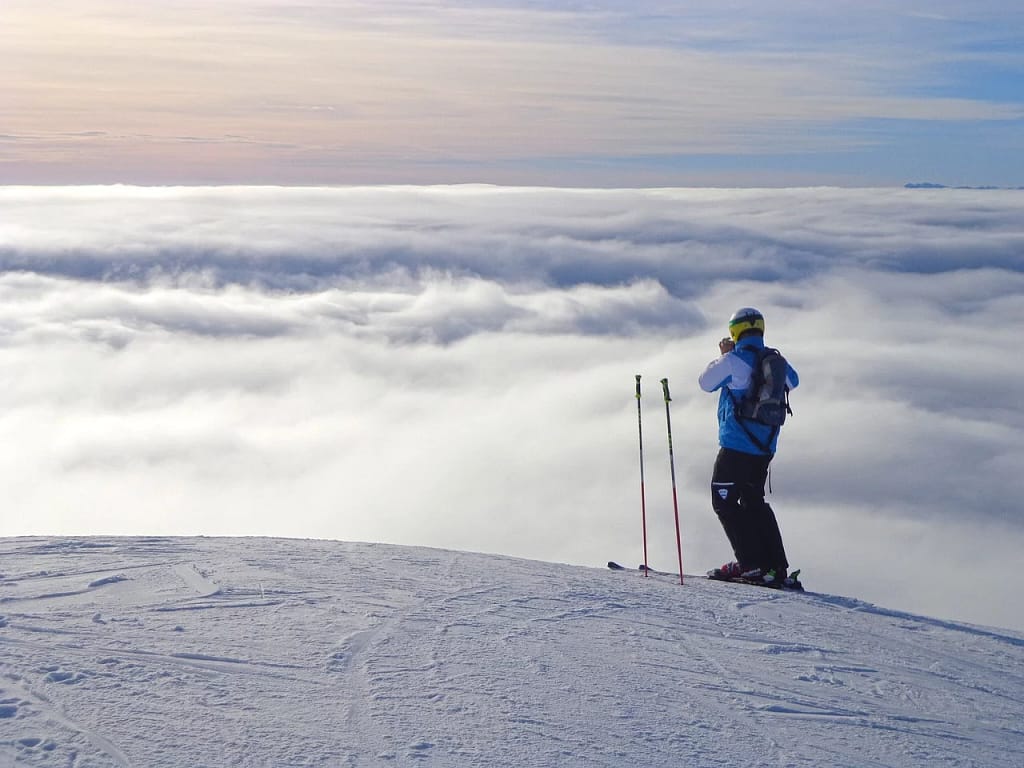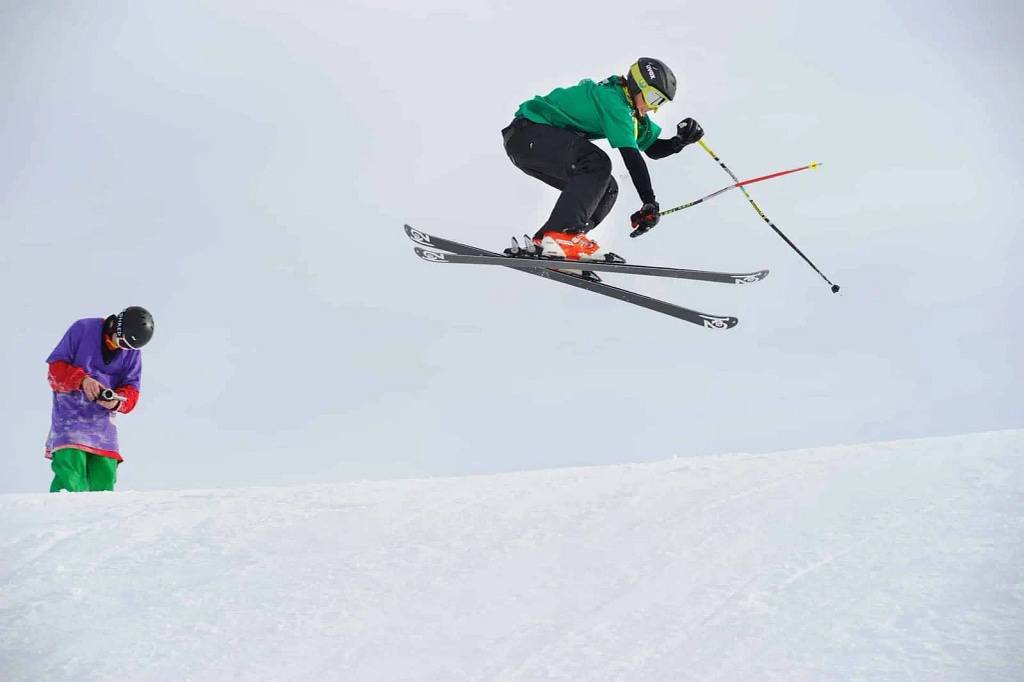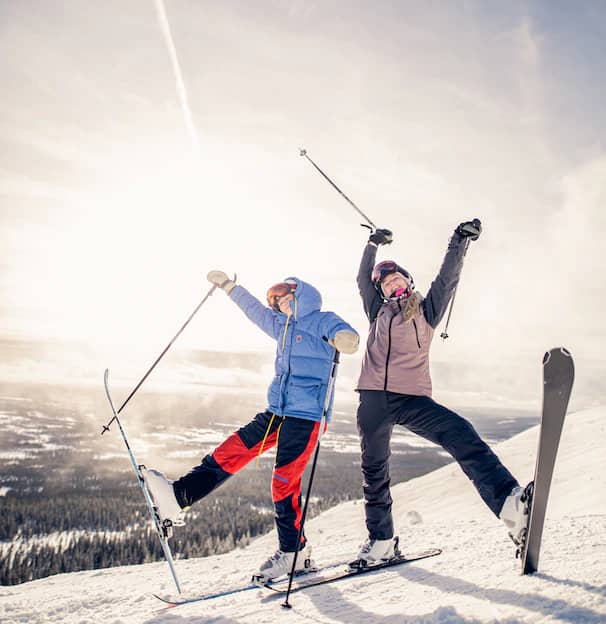Introduction to Knee Strength and Skiing
The Crucial Role of Knee Strength in Conquering the Slopes
Imagine gliding down snowy slopes, the crisp mountain air brushing against your face, and the thrill of every turn. Now, picture doing all that with the confidence that your knees are as strong as the rest of you. That’s right, folks – how to strengthen knees for skiing isn’t just a good-to-know; it’s a must-know for anyone looking to make the most out of their skiing adventures.
Knee strength isn’t just about power; it’s the cornerstone of stability, agility, and endurance on the slopes. Whether you’re a seasoned pro or a snow bunny, having robust knees can mean the difference between a good day and a great one on the mountain. So, let’s dive into the world of knee fortification and uncover the secrets to skiing success.
Why Strong Knees Are Your Best Ally on the Ski Slopes
Imagine your knees as the shock absorbers of your body, taking in the bumps and jumps of the terrain. They’re your loyal sidekicks, allowing you to carve, pivot, and stop with precision. But without proper strength, these unsung heroes can quickly turn into your Achilles’ heel. That’s why understanding how to strengthen knees for skiing is pivotal – it’s about giving your knees the power to support your skiing aspirations.
Stay with me as we embark on this journey to knee empowerment. We’ll explore the intricacies of the knee anatomy, delve into injury prevention, and share a treasure trove of exercises and tips that will set you on the path to unshakable knee strength. Ready to transform your skiing experience? Let’s get those knees slope-ready!

Understanding the Anatomy of the Knee
The knee isn’t just a simple hinge in the machinery of our bodies; it’s a complex and pivotal joint that bears the brunt of our adventurous spirits, especially when we’re carving down snowy slopes. The structure of the knee is a marvel of nature’s engineering, comprising bones, cartilage, ligaments, and tendons that all work in concert. Picture this: the femur (thigh bone), tibia (shin bone), and patella (knee cap) are the bony stars of the show, held together by the ligaments and driven by the muscles and tendons. It’s this ensemble that allows you the flexibility and strength to execute those thrilling ski maneuvers.
But as with any high-performance gear, there’s a risk of wear and tear. Common knee injuries in skiing often include tears to the anterior cruciate ligament (ACL) or the medial collateral ligament (MCL), not to mention meniscus injuries that can occur from the twisting forces during falls or sudden changes in direction. These injuries can bench you for a season, or worse, lead to long-term joint issues.
The Importance of Knee Strength in Skiing
When you’re carving down the slopes, your knees are not just simple hinges in your body; they are the sophisticated shock absorbers and stabilizers that make your skiing experience fluid and dynamic. How to strengthen knees for skiing isn’t just a query for athletes; it’s a fundamental concern for anyone looking to enjoy the snow without the shadow of injury looming overhead.
Knee Strength: The Powerhouse of Your Ski Performance
Imagine your knees as the core of a well-oiled machine. Just as a powerful engine propels a car, strong knees drive your skiing performance, allowing for sharper turns, better balance, and more control. The strength of your quadriceps, hamstrings, and the stabilizing muscles around the knee joint directly impacts your ability to apply force to the skis and navigate the terrain with precision and power.
But it’s not all about the sheer force. The endurance of these muscles also plays a crucial role. Strong knees can sustain the repetitive stress and strain of a long day on the slopes, reducing fatigue and maintaining your form from the first run to the last. This is where how to strengthen knees for skiing becomes a mantra for both the novice and the seasoned skier.
A Shield Against the Slopes: Knee Strength and Injury Prevention
Now, let’s talk about the less glamorous, but equally important, aspect of knee strength: injury prevention. It’s no secret that skiing can be tough on the knees. The twists, turns, and occasional falls can all pose risks to these vital joints. But here’s the silver lining: by strengthening your knees, you’re effectively armoring them against potential harm.
Strong muscles act as a support system for the knee joint, reducing the load on the ligaments and menisci that are often injured during skiing. Think of it as a tightrope walker with a safety net; the net doesn’t prevent the walker from balancing, but it does provide a much-needed safety measure in case of a slip.
Moreover, a well-conditioned knee is more resilient. It can better absorb the shocks and jolts of uneven terrain and unexpected bumps. By focusing on how to strengthen knees for skiing, you’re not just preparing to perform; you’re preparing to protect.
The Synergy of Strength and Skill
Let’s not overlook the synergy between knee strength and skiing technique. Strong knees don’t just reduce the risk of injury; they also enhance your ability to execute proper skiing techniques. Good form is your ticket to efficient skiing, and efficient skiing translates to less wear and tear on your body.
Consider the act of carving. It requires a delicate balance of leaning into your skis while maintaining control. Strong knees provide the stability needed to hold your form through the turn, reducing the strain on other parts of your body. It’s a perfect illustration of how strength complements skill, and vice versa.

Exercises for Strengthening Knees for Skiing
When it comes to hitting the slopes, your knees are your most valuable players. They absorb shocks, help you pivot, and keep you stable as you carve through the snow. So, how to strengthen knees for skiing? Let’s dive into a series of exercises that will not only bolster your knee strength but also enhance your overall skiing prowess.
Quadriceps Strengthening: The Frontline of Knee Support
Your quadriceps, the muscles at the front of your thighs, are knee-stabilizing superstars. To fortify them:
1. Squats:
Stand with feet shoulder-width apart, lower into a squat, keeping your back straight and knees behind your toes. Rise back up and repeat. Aim for 3 sets of 10-15 reps.
2. Lunges:
Step forward with one leg, lowering your hips until both knees are bent at 90-degree angles. Push back up and alternate legs. Perform 3 sets of 10 reps per leg.
3. Leg Presses:
Using a leg press machine, select a moderate weight. Push the platform away with your feet flat and knees aligned with your toes. Return to the starting position with control. Shoot for 3 sets of 10 reps.
Hamstring Curls: Your Behind-the-Scenes Knee Protectors
Hamstrings play a crucial role in knee stability. To strengthen them:
1. Swiss Ball Hamstring Curls:
Lie on your back with your feet on a Swiss ball. Lift your hips and roll the ball towards you by bending your knees. Roll out and repeat for 3 sets of 12 reps.
2. Deadlifts:
Stand with feet hip-width apart, holding weights in front of you. Hinge at the hips, lower the weights while keeping your back flat, then return to standing. Aim for 3 sets of 10-12 reps.
Calf Raises: The Unsung Heroes of Knee Stability
Strong calves aid in controlling your ski movements. To boost calf strength:
1. Standing Calf Raises:
Stand on the edge of a step with heels hanging off. Push up onto your toes, then lower slowly back down. Go for 3 sets of 15 reps.
Balance and Stability Exercises: The Core of Knee Strength
Balance is key in skiing. Try these exercises to improve stability:
1. Single-Leg Balances:
Stand on one leg, hold for 30 seconds, then switch. To increase difficulty, close your eyes or stand on a cushion.
2. Bosu Ball Squats:
Stand on a Bosu ball and perform squats. The instability will force your knees and core to work harder. Do 2 sets of 10 reps.
Plyometric Drills: Power Up Your Knee Strength
Plyometrics can enhance your knee’s explosive power:
1. Box Jumps:
Stand in front of a sturdy box or platform. Jump onto it with both feet, then step back down. Complete 2 sets of 8 reps.
2. Lateral Hops:
Place a line or small object on the ground. Hop side to side over it, landing softly each time. Perform for 1 minute, rest, and repeat twice.
Remember, consistency is key in seeing improvements. Incorporate these exercises into your routine 2-3 times a week, gradually increasing intensity and complexity as your strength builds. Always ensure proper form to prevent injury and maximize benefits. With these targeted exercises, you’re well on your way to fortifying your knees for the skiing season ahead.
By following this guide on how to strengthen knees for skiing, you’ll not only prepare yourself for an epic season on the slopes but also equip your body with the resilience it needs to avoid potential injuries. So, are you ready to give your knees the TLC they deserve? Let’s get those legs in peak ski condition!
Tips for Maintaining Knee Health for Skiing
Maintaining knee health is not just about the exercises you do; it’s about the holistic approach you take towards your overall fitness and wellbeing. Think of it as nurturing a garden. Just as plants need the right soil, water, and sunlight to thrive, your knees require a mix of care strategies to remain strong and resilient. Let’s dive into how you can keep your knees in top condition for those thrilling downhill adventures.
Warm-Ups and Cool-Downs: The Dynamic Duo for Knee Care
Before you hit the slopes, warming up is as essential as strapping on your boots. Imagine your muscles and joints as elastic bands. Cold bands snap easily, but once warmed up, they can stretch and move without damage. Begin with dynamic stretches that mimic skiing movements, like leg swings and lunges. This prepares your knees for the rigorous activity ahead.
Cooling down is equally crucial. After a day of skiing, your muscles are like a revved-up engine. They need to gradually come to a stop to avoid stiffness and soreness. Gentle stretching and foam rolling can help release any tension, keeping your knees flexible and less prone to injury.
Hydration and Nutrition: Fueling the Pillars of Knee Health
Are you sipping on the secret elixir of knee health? Yes, I’m talking about water! Staying hydrated ensures that your joints remain lubricated, reducing the risk of friction and wear. Pair this with a balanced diet rich in omega-3 fatty acids, antioxidants, and vitamins to support muscle recovery and joint health. Foods like salmon, berries, and leafy greens are your knees’ best friends.
Insights from Professional Skiers and Physiotherapists
Ever wondered how professional skiers make those sharp turns and jumps look so effortless? It’s not just talent; it’s also about having knees that are as strong as steel cables. Professional skiers often emphasize the significance of a robust knee conditioning regimen. They know that the knees aren’t just hinges in our legs; they’re the epicenter of power and control when carving through the snow.
Physiotherapists echo this sentiment, underscoring the need for a holistic approach to knee strength. They stress that it’s not only about the muscles around the knees but also the entire kinetic chain – which includes your hips, ankles, and even your core. Keeping this entire system in top shape is the key to not just better skiing, but also to minimizing the risk of injury.
Importance of Regular Check-ups and Listening to Your Body
It’s crucial to remember that even the most seasoned skiers need to listen to their bodies. Regular check-ups with a healthcare professional can catch potential issues before they become problematic. Physiotherapists can provide personalized assessments and tailor exercises specifically to your needs, ensuring that your knee strengthening routine is as effective as it can be.
But what does listening to your body entail? It’s about being attuned to the signals it sends you. If you feel a twinge or a strain, it’s your body’s way of saying, “Hey, take it easy, or let’s get this checked out.” Ignoring these signs can lead to more severe injuries, which could bench you for the season or longer.
Conclusion
Recap of the Importance of Knee Strength in Skiing
As we’ve carved through the snowy slopes of information, it’s crystal clear that knee strength is the linchpin of a skier’s performance. Not only does it enable you to swish down the pistes with greater control and agility, but it also acts as your personal shield against the dreaded specter of injuries. Remember, when we talk about how to strengthen knees for skiing, we’re discussing more than just muscle power; we’re embracing a holistic approach to knee health that can make or break your time on the slopes.
Final Thoughts on ‘How to Strengthen Knees for Skiing
In the grand slalom of skiing prep, zeroing in on how to strengthen knees for skiing is akin to fine-tuning your skis before hitting the powder – it’s non-negotiable. By now, you should feel armed with the know-how to keep those knees robust and resilient. Whether you’re a bunny slope newbie or a black diamond expert, nurturing knee strength is your secret weapon for an epic ski season.

FAQ Section:
1. What are the common knee injuries in skiing?
The most common knee injuries you’ll encounter on the slopes are ACL (anterior cruciate ligament) tears, MCL (medial collateral ligament) injuries, and meniscus tears. The ACL is a critical stabilizer in your knee, and it can be injured if your ski catches the wrong way or during a fall. The MCL, on the other side of the knee, can be strained or torn when there’s a forceful impact on the outside of the knee. The meniscus, that C-shaped cartilage cushioning your knee, can be torn with sudden twists or turns – common when changing direction quickly on the slopes. To help prevent these, always make sure your bindings are properly adjusted, and you’re using the correct technique!
2. How does strengthening the knees help improve skiing performance?
Strong knees are like the shock absorbers of your car – they help you handle the bumps and turns with ease. When your knee muscles are strong, they better support the joint, which can improve your control and stability when skiing. This means you can tackle those turns, jumps, and bumps with more confidence and precision. Plus, strong muscles around the knee can help absorb some of the forces that might otherwise strain your ligaments, reducing the risk of injury. So, by strengthening your knees, you’re essentially upgrading your body’s natural suspension system for a smoother, more powerful ride down the mountain.
3. What are some of the best exercises for ‘how to strengthen knees for skiing?
Great question! There are several exercises that can help you build knee strength specifically for skiing. Squats and lunges are classics for a reason – they target the quadriceps, hamstrings, and glutes, which are crucial for knee support. Make sure to keep your form in check to get the most out of these exercises and prevent injury. Wall sits are also fantastic for building endurance in those leg muscles. For something a little lower impact, try leg presses or cycling. And don’t forget to include some balance-focused exercises like single-leg deadlifts or using a balance board – these will help train the stabilizing muscles around your knees. Remember, consistency is key, so incorporate these exercises into your routine a few times a week.
4. Why is maintaining knee health important for skiing?
Maintaining knee health is like taking care of your skis – it’s essential for a good time on the slopes. Your knees are crucial for absorbing the impact of the terrain, pivoting, and controlling your movements. If they’re not in good shape, not only can your skiing technique suffer, but you’re also at a higher risk of injury, which can sideline you for the season or longer. Plus, healthy knees can help you ski longer without fatigue, meaning more fun and more runs before the day is out. So, give your knees the attention they deserve with regular strengthening, proper rest, and listening to your body when it tells you something’s off.
5. What professional advice is there for strengthening knees for skiing?
Professionals will tell you that knee strength for skiing isn’t just about doing a few exercises; it’s about a comprehensive approach. First, they’ll emphasize the importance of a well-rounded fitness routine that includes cardiovascular training, strength training, and flexibility exercises. They’ll also stress the need for proper technique both in your workouts and on the slopes. Many pros recommend working with a physical therapist or a certified trainer who understands the demands of skiing to create a personalized program. They’ll also remind you to not neglect rest and recovery – your muscles need time to rebuild after being stressed. And lastly, they’ll say to listen to your body. If something feels off, don’t push through pain. It’s better to take a step back and address the issue than to risk a more serious injury.





No responses yet